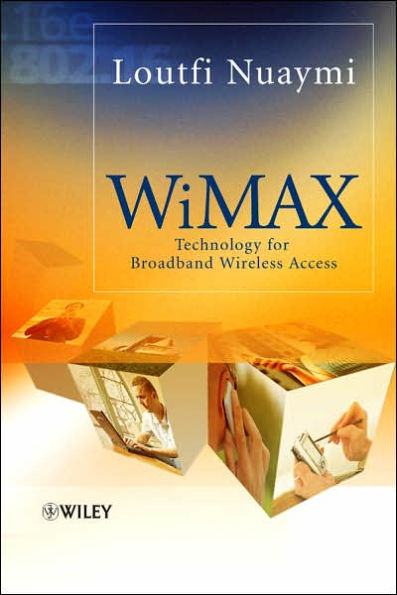WiMAX: Technology for Broadband Wireless Access / Edition 1 available in Hardcover

WiMAX: Technology for Broadband Wireless Access / Edition 1
- ISBN-10:
- 0470028084
- ISBN-13:
- 9780470028087
- Pub. Date:
- 03/12/2007
- Publisher:
- Wiley

WiMAX: Technology for Broadband Wireless Access / Edition 1
Hardcover
Buy New
$129.95Overview
The WiMAX System is described in thousands of pages of IEEE 802.16 standard and amendments documents and WiMAX Forum documents. WiMAX: Technology for Broadband Wireless Access provides a global picture of WiMAX and a large number of details that makes access to WiMAX documents much easier. All the aspects of WIMAX are covered. Illustrations and clear explanations for all the main procedures of WiMAX are pedagogically presented in a succession of relatively short chapters
- Topics covered include WiMAX genesis and framework, WiMAX topologies, protocol layers, MAC layer, MAC frames, WiMAX multiple access, the physical layer, QoS Management, Radio Resource Management, Bandwidth allocation, Network Architecture, Mobility and Security
- Features a glossary of abbreviations and their definitions, and a wealth of explanatory tables and figures
- Highlights the most recent changes, including the 802.16e amendment of the standard, needed for Mobile WiMAX
- Includes technical comparisons of WiMAX vs. 802.11 (WiFi) and cellular 3G technologies
This technical introduction to WiMAX, explaining the rather complex standards (IEEE 802.16-2004 and 802.16e) is a must read for engineers, decision-makers and students interested in WiMAX, as well as other researchers and scientists from this evolving field.

Product Details
| ISBN-13: | 9780470028087 |
|---|---|
| Publisher: | Wiley |
| Publication date: | 03/12/2007 |
| Pages: | 310 |
| Product dimensions: | 6.90(w) x 10.00(h) x 0.96(d) |
About the Author
Read an Excerpt
Table of Contents
Preface and Acknowledgements xv Abbreviations List xvii Part One Global Introduction to wIMAX 1 1 Introduction to Broadband Wireless Access 3 1.1 The Need for wireless Data Transmission 31.2 Wireless Networks and Broadband Wireless Access (BWA) 4
1.3 Application of BWA 8
1.4 History of BWA Technologies 11
2 WiMAX Genesis and Framework 13
2.1 IEEE 802.16 Standard 13
2.2 WiMAX Forum 15
2.3 WiMAX Products Certification 16
2.4 Predicted Products and Deployment Evolution 19
2.5 Other 802.16 Standards 20
2.6 The Korean Cousin: WiBro 21
3 Protocol Layers and Topologies 23
3.1 The Protocol Layers of WiMAX 23
3.2 Convergence Sublayer (CS) 25
3.3 Medium Access Control Common Part Sublayer (MAC CPS) 25
3.4 Security Sublayer 25
3.5 PHYsical Layer 26
3.6 Network Management Reference Model 28
3.7 WiMAX Topologies 28
4 Frequency Utilisation and System Profiles 31
4.1 The Cellular Concept 31
4.2 Licensed and Unlicensed Frequencies 36
4.3 WiMAX Frequencies, Regulations and Availability 38
4.4 WiMAX System Profiles 41
Part Two WiMAX Physical Layer 43
5 Digital Modulation, OFDM, and OFDMA 45
5.1 Digital Modulations 45 5.2 OFDM Transmission 47
5.3 OFDMA and Its Variant SOFDMA 53
5.4 Subcarrier Permutations in WiMAX OFDMA PHY 57
6 The Physical Layer of WiMAX 69
6.1 The 802.16 Physical Transmission Chains 69
6.2 Channel Coding 69
6.3 Turbo Coding 74
6.4 Transmission Convergence Sublayer (TCS) 77
6.5 Burst Profile 78
Part Three WiMAX Multiple Access (MAC Layer) and QoS Management 81
7 Convergence Sublayer (CS) 83
7.1 CS in 802.16 Protocol Architecture 83
7.2 Connections and Service Flow 83
7.3 Classifications and Mapping 88
7.4 CS and QoS 90
7.5 Payload Header Suppression (PHS) 90
8 MAC Functions and MAC Frames 95
8.1 Introduction 95
8.2 MAC Addresses and MAC Frames 95
8.3 Fragmentation, Packing and Concatenation 100
8.4 Basic, Primary and Secondary Management Connections 102
8.5 User Data and MAC Management Messages 105
8.6 TLV Encoding in the 802.16 Standard 8.6.1 TLV Encoding Sets 106
8.7 Automatic Repeat Request (ARQ) 106
8.8 Scheduling and Link Adaptation 110
9 Multiple Access and Burst Profile Description 113
9.1 Introduction 113
9.2 Duplexing: Both FDD and TDD are Possible 113
9.3 Transmission of Downlink and Uplink Subframes 115
9.4 Maps of Multiple Access: DL-MAP and UL-MAP 121
9.5 Burst Profile Usage: DCD Message and the DIUC Indicator 125
9.6 Mesh Frame 134
10 Uplink Bandwidth Allocation and Request Mechanisms 137
10.1 Downlink and Uplink Allocation of Bandwidth 137
10.2 Types of Uplink Access Grant-request 138
10.3 Uplink Access Grant-request Mechanisms 140
10.4 Contention-based Focused Bandwidth Request in OFDM PHY 150
10.5 Contention-based CDMA Bandwidth Request in OFDMA PHY 153
11 Network Entry and Quality of Service (QoS) Management 155
11.1 Ranging 155
11.2 Link Adaptation 161
11.3 The Five Scheduling Services or QoS Classes 163
11.4 Scheduling and deployment of Services Over WiMAX 167
11.5 Dynamic Service Addition and Change 170
11.6 Network Entry 175
Part Four Diverse Topics 183
12 Efficient Use of Radio Resources 185
12.1 Introduction 185
12.2 Radio Engineering Consideration for WiMAX Systems 186
12.3 Radio Resource Management Procedures 189
12.4 Advanced Antenna Technologies in WiMAX 194
12.5 Multicast Broadcast Services (MBS) 204
13 WiMAX Architecture 207
13.1 The Need for a Standardized WiMAX Architecture 207
13.2 Network Reference Model 209
13.3 Network Functionalities 215
14 Mobility, Handover and Power-Save Modes 219
14.1 Handover Considerations 219
14.2 Network Topology Acquisition 220
14.3 The Handover Process 222
14.4 Fast BS Switching (FBSS) and Macro Diversity Handover (MDHO) 225
14.5 Power-Save Modes 227
15 Security 231
15.1 Security Elements Used in the 802.16 Standard 231
15.2 Authentication and the PKM Protocol 235
15.3 Data Encryption 242
15.4 Message Authentication with HMAC 248
15.5 Other Security Issues 250
16 Comparisons and Conclusion 251
16.1 Comparison Between Fixed WiMAX and Mobile WiMAX 251
16.2 Comparison Between WiMAX and WiFi 252
16.3 Comparison Between WiMAX and 3G 253
16.4 Final Thoughts and Conclusion 254
Annex A: The Different Sets of MAC Management Messages 255
Annex B: Example of a Downlink Channel Descriptor (DCD) Message 265
References 273
Index 277
